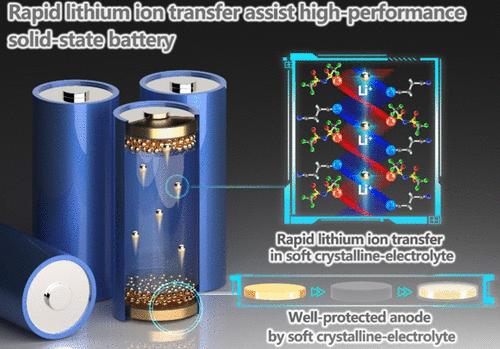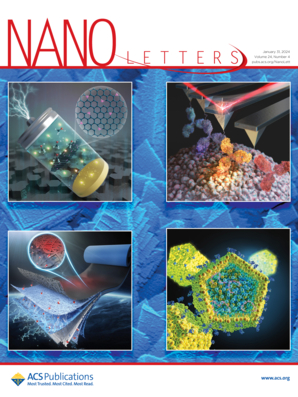晶体电解质提升全固态锂离子电池的高性能
IF 9.6
1区 材料科学
Q1 CHEMISTRY, MULTIDISCIPLINARY
引用次数: 0
摘要
在全固态锂离子电池(ASSB)中,固体电解质与电极之间的界面存在僵硬的固-固接触,这给锂离子传输带来了相当大的挑战。为了解决这个问题,我们建议使用锂浓缩琥珀腈(Li-SN45)作为 ASSB 中高效的双边界面改性剂。这种材料的离子电导率高达 3.38 mS cm-1,对锂金属阳极具有优异的耐腐蚀性。使用分层阴极和锂金属组装的 ASSB 具有出色的放电容量(170 mAh g-1 @ 20 mA g-1)和卓越的长期循环性能(100 次循环后容量保持率为 97%)。MALDI-TOF 结果表明,Li-SN45 中形成了晶体结构,这有利于在氧原子的协助下实现 "无阴离子 "Li+跳跃路径。我们的发现丰富了人们对 ASSB 电解质中锂离子输运动力学的理解,为设计具有快速锂离子输运能力的新一代 ASSB 铺平了道路。本文章由计算机程序翻译,如有差异,请以英文原文为准。

Crystalline Electrolyte Boosts High Performance of All-Solid-State Lithium-Ion Batteries
The rigid solid–solid contact at the interface between the solid electrolyte and electrodes in full-solid-state lithium-ion batteries (ASSBs) presents a considerable challenge to lithium ion transport. To address this, we propose using Li-concentrated succinonitrile (Li-SN45) as an efficient bilateral interface modifier in ASSBs. This material boasts exceptional ionic conductivity of 3.38 mS cm–1 and excellent corrosion resistance to the Li metal anode. The assembled ASSBs using layered cathodes and Li metal demonstrate outstanding discharge capacity (170 mAh g–1 @ 20 mA g–1) and superior long-term cycling performance (97% capacity retention after 100 cycles). MALDI-TOF results suggest the formation of a crystalline structure in Li-SN45, which facilitates smooth “anion-free” Li+ hopping paths assisted by the oxygen atoms, as revealed by the solved crystal structure. Our findings enriched the understanding of Li transport dynamics in electrolytes of ASSBs, paving the way to designing superior next-generation ASSBs with fast Li transport.
求助全文
通过发布文献求助,成功后即可免费获取论文全文。
去求助
来源期刊

Nano Letters
工程技术-材料科学:综合
CiteScore
16.80
自引率
2.80%
发文量
1182
审稿时长
1.4 months
期刊介绍:
Nano Letters serves as a dynamic platform for promptly disseminating original results in fundamental, applied, and emerging research across all facets of nanoscience and nanotechnology. A pivotal criterion for inclusion within Nano Letters is the convergence of at least two different areas or disciplines, ensuring a rich interdisciplinary scope. The journal is dedicated to fostering exploration in diverse areas, including:
- Experimental and theoretical findings on physical, chemical, and biological phenomena at the nanoscale
- Synthesis, characterization, and processing of organic, inorganic, polymer, and hybrid nanomaterials through physical, chemical, and biological methodologies
- Modeling and simulation of synthetic, assembly, and interaction processes
- Realization of integrated nanostructures and nano-engineered devices exhibiting advanced performance
- Applications of nanoscale materials in living and environmental systems
Nano Letters is committed to advancing and showcasing groundbreaking research that intersects various domains, fostering innovation and collaboration in the ever-evolving field of nanoscience and nanotechnology.
 求助内容:
求助内容: 应助结果提醒方式:
应助结果提醒方式:


